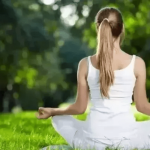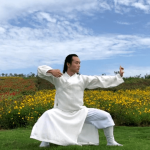Where should you meditate?
- Ideal Meditation Environment:
- Quiet Place: Choose a quiet environment free from external disturbances to ensure optimal concentration.
- Suitable Space: Your meditation space doesn’t need to be large; it can be a balcony or a corner in the living room.
- Minimize Distractions: Turn off electronic devices such as TVs and put your phone on silent mode to avoid interruptions.
- Not Complete Silence: Meditation doesn’t require absolute silence; minor noises like car honks or dogs barking won’t disrupt your practice.
- Mindful Awareness of Noise:
- Acknowledge External Sounds: Be aware of external noises but maintain focus on your meditation practice.
- Learn to Ignore: Practice ignoring external distractions, recognizing them without allowing them to disrupt your inner peace.
- Importance for Beginners:
- Concentration: Ensuring a distraction-free environment aids beginners in focusing their attention during meditation.
- Establishing Routine: Creating a dedicated meditation space and minimizing distractions helps establish a consistent meditation routine.
- Inner Peace: Learning to ignore external noises fosters a sense of inner calm and enhances the effectiveness of meditation practice.
What position should you use for meditation?
- Versatility of Meditation Positions:
- Any Position: In theory, meditation can be practiced in various positions, including standing, sitting, or lying down.
- Potential Issues: Lying down may lead to drowsiness, while standing might induce fatigue during meditation.
- Recommended Meditation Posture:
- Cross-Legged Sitting: A cross-legged sitting posture is commonly recommended for meditation due to its balance of comfort and alertness.
- Lower Back Consideration: Maintaining a cross-legged position may cause discomfort in the lower back, especially for those with limited flexibility.
- Starting Position for Beginners:
- Grounded Sitting: Begin by sitting with your feet flat on the ground and your hands resting on your thighs.
- Straight Back: Aim to keep your back straight without being overly rigid, promoting proper posture during meditation.
- Back Support: Use a small cushion if needed to provide support for the lower back and enhance comfort during meditation.
- Eye Position:
- Closed Eyes: Pour les débutants, meditating with closed eyes is recommended to minimize external distractions and enhance focus on inner awareness.

How long should you meditate?
- Frequency and Duration of Meditation:
- Experienced Recommendation: Experienced meditators suggest meditating twice daily for approximately 20 minutes per session.
- Beginner Approach: Beginners can start with shorter sessions, aiming for about 5 minutes of meditation each day.
- Setting a Timer:
- Avoiding Time Distractions: Before beginning meditation, set an alarm to avoid becoming distracted by concerns about time passing slowly during the practice.
- Enhancing Focus: Having a timer in place allows practitioners to maintain focus without worrying about tracking time during meditation.
- Gradual Increase in Duration:
- Progressive Adjustment: As individuals become more accustomed to meditation, they can gradually increase the duration of each session.
- Recommended Session Length: For optimal results, aim for meditation sessions lasting between 10 à 20 minutes as proficiency grows over time.
How do you meditate?
- Choosing a Meditation Technique:
- Variety of Methods: There are numerous meditation techniques available, including focused attention, mantra repetition, and walking meditation.
- Focus on Mindfulness: Today’s focus will be on mindfulness meditation, which is widely practiced and beginner-friendly.
- Preparation for Meditation:
- Comfortable Environment: Find a comfortable and quiet space to meditate, and close your eyes to minimize distractions.
- Deep Breathing: Begin by taking slow and deep breaths, inhaling and exhaling through your nose in a natural rhythm.
- Observing the Breath:
- Central Focus: Direct your attention to your breath, observing its entire journey from inhalation to exhalation.
- Sensory Awareness: Notice the sensation of air entering your nostrils, passing through your throat, and filling your chest, then observe its release as it exits your body.
- Body Scan:
- Comprehensive Awareness: While focusing on your breath, scan your body from head to toe, noticing any sensations or movements associated with your breathing.
- Heightened Sensitivity: Pay attention to how your body responds to each breath, including the subtle changes and sensations that arise.
- Benefits of Mindfulness Meditation:
- Stress Reduction: Practicing mindfulness meditation can help alleviate stress and promote relaxation.
- Anxiety Relief: By cultivating present-moment awareness, mindfulness meditation can also reduce feelings of anxiety and promote a sense of calmness.

How long does it take to see results from meditation?
- Individual Variation in Effects:
- Varied Outcomes: The impact of meditation differs among individuals, influenced by factors such as experience level and chosen method.
- Long-Term Development: Achieving heightened awareness and profound consciousness akin to seasoned practitioners may require years of dedicated practice.
- Meditation as a Journey:
- Metaphor of Climbing a Mountain: Similar to ascending a mountain, meditation is a journey marked by gradual progress and personal growth.
- Incremental Advancement: Each meditation session serves as a step forward on this journey, leading closer to the ultimate destination.
- Shift in Focus:
- Emphasizing Outcome: Rather than fixating on the act of meditation itself, prioritize the outcomes it brings.
- Indicators of Success: Feeling increased calmness, joy, and inner peace post-meditation signifies its effectiveness.
- Acceptance of Progress:
- Incremental Improvement: Acknowledge and celebrate even small advancements in meditation practice.
- Patience and Persistence: Consistent effort over time leads to profound transformations in meditation.
More to learn:
Qu'est-ce que Ba Duan Jin? Le tutoriel le plus complet pour vous.
Que doivent savoir les débutants en Qigong? Méthodes rapides pour démarrer
Savez-vous comment méditer? Le moyen simple de le faire
Comment apprendre le Qi Gong? 12 Ce que les débutants doivent savoir
Qu'est-ce que le Qi Gong? Comment le comprendre facilement?
Le Qigong est-il réel? Laissez-moi partager ma véritable expérience
Qu'est-ce que le Qi Gong? comment ça marche ? Quelque chose que vous devez savoir


